Plinth heating: features of installing water and electric warm skirting
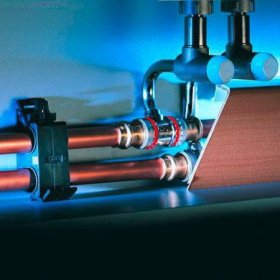
The problem of heating a private house is usually solved in the traditional way: a circulation heating system is installed. Water heated in the boiler room moves along pipes in one or two circuits; as a result, heat from the radiators is transferred to the indoor air. But this system has one drawback - unevenness, the air in the floor remains cool. Given this feature, it is better to choose a more appropriate method of heating - a warm water baseboard or its electrical equivalent.
Content
Baseboard heating classification
There are two types of plinth heating: in the first case, heating occurs with the help of electricity, in the second - a heat carrier heated to a certain temperature.
Radiator blocks of the electrical system are equipped with air heating elements with a power of 200 W / linear meter. m built into one of the copper tubes. The second tube is for a power cable insulated with silicone heat-resistant material. Power is supplied to the system from a conventional electrical outlet. A warm baseboard of this type is used to heat any room, except those where the humidity level is exceeded.
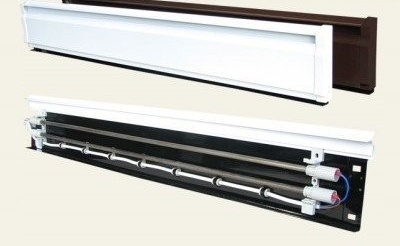
Installation of an electric heating system is much easier than water. Heating elements are inside the box, and additional devices such as a manifold or lead pipes are not needed
Plinth water heating is a system consisting of the following elements:
- Distribution collector - a pair of steel tubes through which the coolant is supplied and returned.
- Warm baseboard (radiator), consisting of two parts - the heat exchanger and the duct in which it is enclosed.
- A set of plastic tubes: the first - a smooth smaller diameter is enclosed in a second, wider, corrugated, which plays the role of a cover.
The copper tubes of the heat exchanger, as a rule, have standard sizes: the outer diameter is 1.3 cm, the inner is 1.1 cm. The lamellas made of brass or aluminum with a high degree of thermal conductivity are fixed on the tubes.
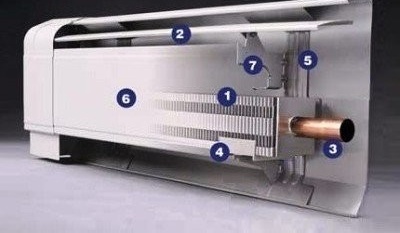
Plinth convector device layout: 1 - plates (lamellas), 2 - air damper, 3 - copper pipe, 4 - plastic gasket, 5 - bracket for fixing in the box, 6 - steel panel, 7 - caliper
The pipe through which the coolant is supplied is not without reason enclosed in a corrugated shell. This is not only protection, but also a quick change method. The pipe is mounted in a wall or floor, and in case of plastic wear, the inner tube is easy to replace by pulling it out of the wide one. Fortunately, repairs are extremely rare, since plastic pipes are resistant to salts dissolved in water, and air is not allowed inside the system.
Baseboard heating principle
The process of using baseboard heating radiators differs from the operation of conventional heating devices, which, due to the high temperature, transfer their heat to the surrounding air, thereby heating the room. The skirting system acts thanks to the “sticking” effect of heated air to a nearby surface - in this case, to the wall.
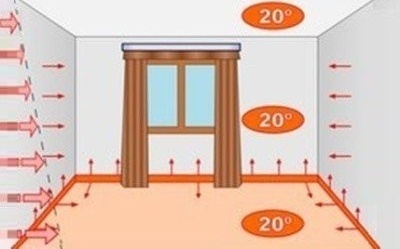
The plinth heating system ensures even distribution of heated air throughout the room. It prevents the formation of condensation, and consequently, dampness and mold.
Radiators are installed around the entire perimeter of the room or in certain areas, but always along the walls. The metal boxes inside which the heating elements are hidden are not tight: they have two special slots in the lower and upper parts. Air enters the box through an opening close to the floor, heats up to a certain temperature and exits through the upper slot, but does not spread in all directions, but spreads up the wall. Thus, the heated air transfers its heat not to the whole room, but only to the surface near which the baseboard radiator is located. And already further, from the wall, heat enters the air, resulting in a more uniform heating of the room.
The radiator elements must have high thermal conductivity, so most of the equipment is made of aluminum and copper. It is impractical to heat plinth radiators to a maximum temperature, 40 ° C is enough. With this value, the temperature of the heated wall is 2-4 degrees lower, that is, it is absolutely safe for people.
Self-installation of the “warm skirting” system
Let us consider in more detail what to look for when installing heating equipment yourself. It must be borne in mind that the water and electrical systems have a number of features and differ in the way they function.
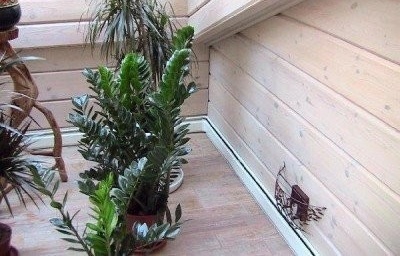
Skirting type heating systems are an excellent option for landscaping such premises as a winter garden, a heated balcony, a loggia, a veranda
Electrical system
The complexity of installation is that the external elements of the electric warm skirting board are just the tip of the iceberg, and its installation is the final, easiest step. The main work is planned even at the time of design, when options for connecting communications - pipes and related electrical equipment are considered.
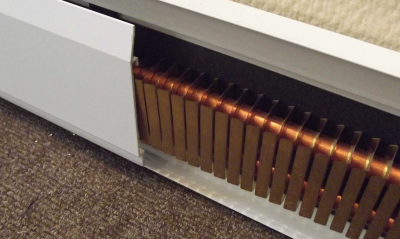
The thermal conductivity of copper is 390 W / m • K, and aluminum - 236 W / m • K. Due to their high performance, these two metals are used in the manufacture of skirting board components.
First, lay a power cable (220 V) with exits at the points of connection of the heating elements and thermostats, then fill the floors, plaster the walls, and finish the room. If errors occur during the installation of the power cable or engineering equipment, it will be quite difficult to fix them - at least you will have to open the cement screed.
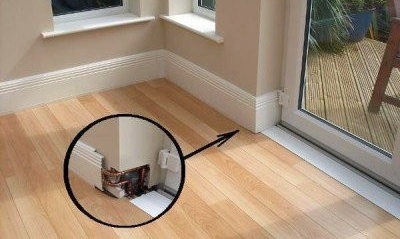
Unfortunately, the footage of a warm baseboard is limited. Usually the length of one circuit should not exceed 15 m, otherwise the system will work inefficiently
Skirting elements are installed last, when the finishing work is completely completed. It is necessary to act strictly according to the scheme that comes with the equipment. As a rule, work comes down to placing elements along the walls, connecting to power, adjusting thermostats.
Water heating
Before installing a warm water baseboard with your own hands, it is necessary to lay PVC pipes from the collector to the installation site. Then, heating elements are attached along the perimeter or in selected places, heating modules are connected in parallel. After crimping and balancing, the automatic system is finally debugged and a trial run is made.
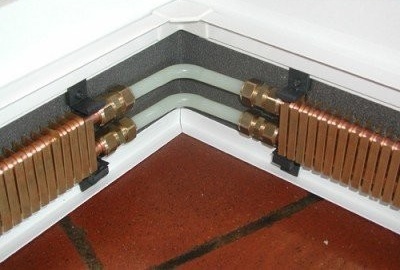
In order for the plastic tubes to last longer, several conditions must be observed.For example, the temperature of the coolant should not exceed 85 degrees, and the pressure should rise above 3 atmospheres
Advantages and disadvantages: expert opinion
One of the advantages, of course, is a neat, almost decorative appearance. Radiators, even in their sizes slightly differing from ordinary skirting boards, take up very little space and are located where they do not bother anyone - on the floor, near the wall itself. This means that there are more options for arranging furniture, and curtains can hang freely without clinging to the edges of traditional batteries.
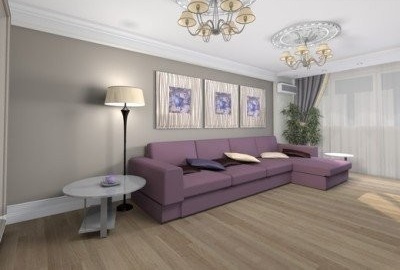
Warm baseboard has a modern look, takes up little space and fits into the interior, arranged in almost any style: from country to modern
Another plus of the plinth heating system is the uniform heating of the entire area of the room. There are no zones of warmer or cooler air, as there is no convection. Consequently, the temperature of the air gap under the ceiling and near the floor will be the same, and this has a beneficial effect on people's health and the state of finishing materials.
Do not forget about the savings. Fuel consumption is markedly reduced due to the low heating temperature, on average by 35-40%. In addition, the installation of skirting equipment is fast, as well as its repair. It is possible to install a separate thermostat in each room and use it to control the heating: in the children's room, set the temperature a little higher, in the bedroom - a couple of degrees lower.
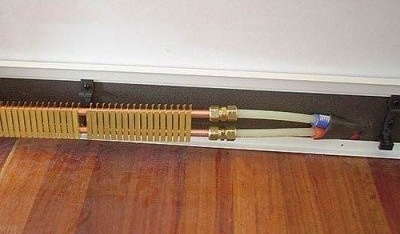
They do not recommend creating elements of a warm baseboard with their own hands, since there are no guarantees of its proper and efficient operation. It is better to purchase expensive, but high-quality equipment of a well-known manufacturer
The disadvantages include the high cost of equipment. This amount includes special materials and system installation. The installation of equipment must be carried out by competent specialists authorized by the manufacturer. Mounting the system yourself, you can miss a number of important points, which will lead to quick wear of equipment and permanent repairs.
It is advisable that the skirting radiators not be covered by anything: neither decorative overlays, nor pieces of furniture. Heat dissipation is sharply reduced, and the heating of the room becomes inferior.
Despite some shortcomings, the warm skirting board is becoming increasingly popular, and the time is not far off when it will completely supersede the traditional convection-type systems for today.

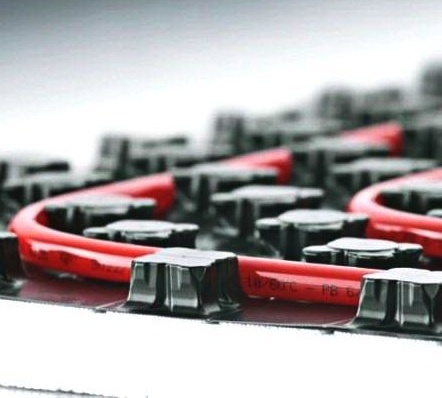
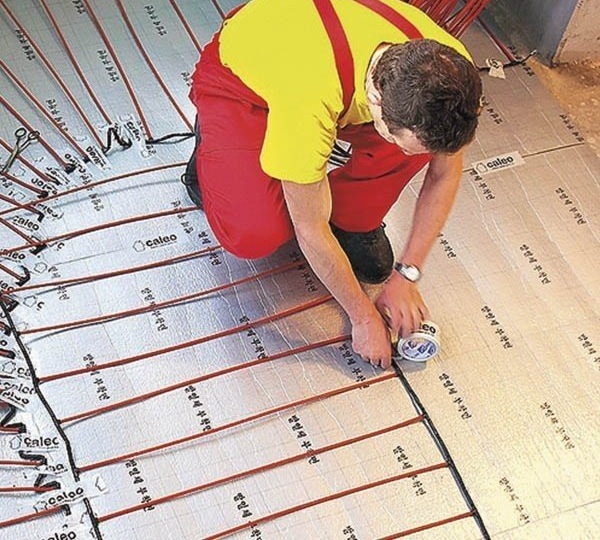
5 comments